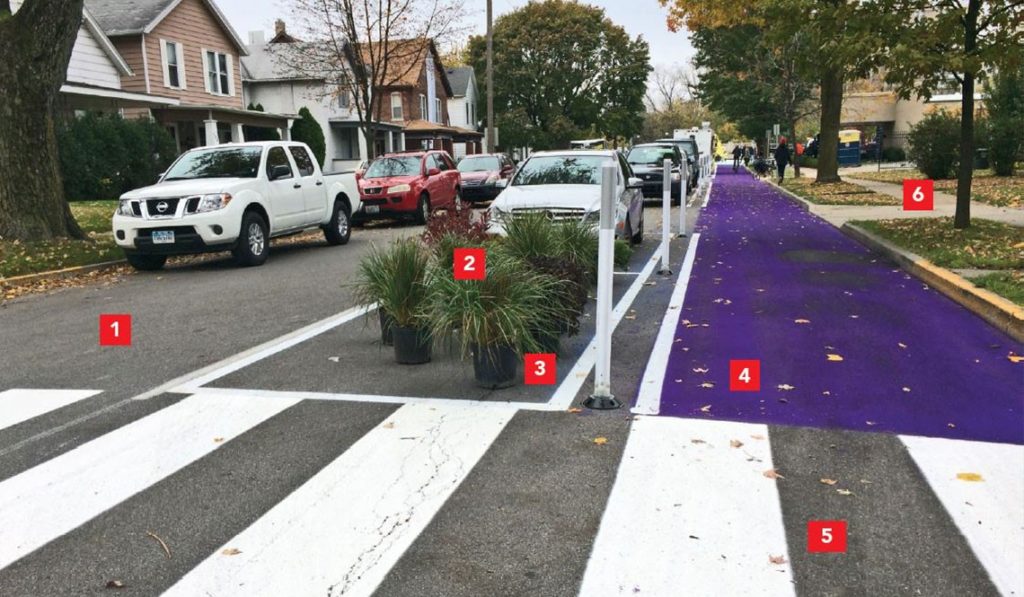Strides toward streets that welcome walkers and cyclists, as well as cars
A stroll to the local grocery store to get milk and bread, chatting with neighbors along the way. A leafy bike lane separated from car traffic makes it easy to commute to work. Rather than the old-school model of simply creating fast lanes for cars to cruise, streets in the U.S. are getting better at embracing a variety of modes of transportation. With these enhancements, you might even call them “complete streets” – and many people do.
In the fifteen years since the National Complete Streets Coalition emerged in 2004, 1325 agencies at the local, regional, and state levels have adopted more than 1400 Complete Streets policies nationwide. Since 2009, many of the biggest states, in addition to local governments, have adopted Complete Streets laws and policies—including California, Texas, New York, Florida, Illinois, Pennsylvania, Massachusetts, and Michigan. The goal: creating healthier, safer streets designed to welcome pedestrians, bicyclists, motorists and transit riders of all ages and abilities.
Complete streets policies also recognize streets as more than purely transportation, by emphasizing public spaces that sustain social and commercial interaction. Residential streets especially define neighborhoods and local quality of life in neighborhoods.
Examples of Complete Streets policies in action include:
- Public Square, Las Cruces, New Mexico: the city opened Plaza de Las Cruces in 2016, a public gathering space located in the center of the town. The site is enhanced by pedestrian improvements on surrounding streets and a new form-based code that requires development around the plaza to be a dense mix of housing and retail spaces.
- FDOT Design Manual: The Florida Department of Transportation (FDOT) has laid the groundwork for safer, more accessible communities with a design manual to help transportation engineers and planners better consider community context when planning and designing state roads. The manual guides FDOT staff in picking the best road design for different types of environments.
- Trail System, Warsaw, Missouri: Warsaw is a rural community that gradually created a comprehensive mixed-use trail system along its waterfront with connections to downtown, historic sites, and recreational facilities throughout the region. The trail system is an iconic destination that attracts visitors, private developers, and new residents to the town.
Keep Your Eyes on the Road
Yet, even as Complete Streets policies have proliferated nationally, implementation on the ground is seeking to catch up. It turns out that sharing the street is not always easy, and can be dangerous. Pedestrians—especially children, the elderly, and people with disabilities–are often challenged with how to safely navigate intersections on arterial roadways with multiple lanes and short lights
Between 2008 and 2017, drivers in the United States struck and killed 49,340 pedestrians. Those most at risk include states and metropolitan areas across the southern continental United States, older adults, people of color, and people walking in low-income communities.
Common deterrents to implementing a Complete Streets policy include the high cost involved with implementation and the time necessary to achieve results. There are signs of progress, however. For example, while Florida has still a troubling state pedestrian safety record, data analysis indicates it has actually reduced its pedestrian fatality rate by half since it adopted a complete streets policy in 1984.
Where can we go from here?
Some would argue that the perfect is the enemy of the good when it comes to Complete Streets policies. If planning, designing, and fully funding the overhaul of a local car-centric street network is financially impossible, shorter-term, affordable approaches to improving street accessibility should not be dismissed.
Team Better Block is a placemaking-focused firm that has partnered with AARP to launch several pop-up demonstration projects bringing people to work together on streets and public places for instance place-making using materials and resources found in the community.

The “Complete Street” makeover above is a demonstration project aimed at educating the public about complete streets and removing the fear of change from city transportation officials. Instant updates include a one-way roadway with on-street curb parking (1). A landscaped bed, represented by potted plants (2), serves as a “swale,” or pervious surface for capturing storm water. A floating parking lane (3) located away from the curb becomes a safety buffer for a “limitless lane” (4), which is wider and slower than a traditional bike lane and is created for the shared use of bicyclists, people in wheelchairs, joggers and others. Pedestrians are provided a very visible crosswalk (5) and an existing sidewalk (6) is safely away from the vehicle and bicycling lanes.
More recently, the National Complete Streets Coalition has revised the criteria for their grading of Complete Streets policies, now emphasizing the importance of a policy that actually turns into practice. To earn a top grade, Complete Streets Policies must now include a clear plan for implementation as well indicate how a community will prioritize its more vulnerable users, people of color, and older adults.
Federal funds, policies, and guidance can also play a key role to prioritize safer streets. A handful of leaders in the U.S. House and Senate recently introduced The Complete Streets Act of 2019, that would require states to set aside money for Complete Streets projects, create a statewide program to award the money and provide technical support, and adopt design standards that support safer, complete streets.
Communities benefit from streets that connect and enhance neighborhoods. Achieving the ideals of multi-modal access for people of all ages and abilities requires long-term persistence and vision, as well as short-term successes. These combined efforts are what it takes to truly “complete the street.”
Post by Deborah Myerson, Executive Director at South Central Indiana Housing Opportunities (SCIHO) in Bloomington, Indiana.

